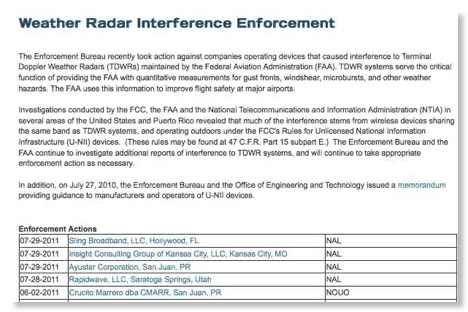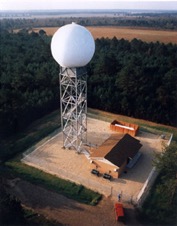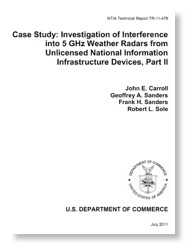U-NII/Weather Radar Interference Update

The FCC/EB webpage linked to the picture above now lists 17 FCC enforcement actions related to U-NII interference to FAA TDWR weather radars since 2007. For those not familiar with the jargon here, a March post here reported how 5 GHz unlicensed U-NII equipment operating in the 5.47-5.725 GHz band are required to have dynamic frequency selection (DFS) as defined by 15.407(h), basically a listen-before-talk (LBT) cognitive radio system, in order to avoid interference to several types of federal government radar systems that operate in the same band. The Terminal Doppler Weather Radar, an FAA weather radar near airports, has been receiving interference in several cases despite this requirement. The big question - Why?
NTIA/ITS recently released the second of a 3 part report series that deals with the issue as shown at left. This report has the following interesting quote:
(One)U-NII device was tested against FCC DFS certification waveforms and it did not detect any. It also failed to detect any emulated TDWR waveforms. The device, however, was FCC certified, meaning it had passed these same tests when the FCC laboratory tested its DFS performance. A firmware update from the manufacturer eventually rectified this problem, illustrating how firmware upgrades can lead to DFS non-compliance.
This strongly implies that the manufacturer changed the firmware after FCC approval. While the original FCC software defined radio (SDR) rules would have made such a software change a Class 3 Permissive Change and required regulatory review, the softening of the rules in Docket 03-108 and deletion of the former 2.932(e) gave a green light to such software changes.
Two March 2010 enforcement actions seem to confirm this. These involved Airspan and Motorola. Airspan agreed in a consent decree as follows:
Remedial Measures. Airspan has developed and distributed to its United States MicroMAX customers a software upgrade for its MicroMAXdevice that prevents users from disabling the DFS radar detection mechanism and varying any other operating parameters of the device.
Thus they were selling a unit where the users could turn off the required DFS capability needed to protect safety-related FAA radars! Airspan agreed to make a $10,000 “voluntary payment” to the Treasury as part of the consent decree.
Motorola agreed to a $9,000 “voluntary payment” but their consent decree is more cryptic than the one for Airspan or a similar one for Axxcelera Broadband Wireless, Inc. that appears to be based on a hardware component issue not a software change. The Airspan consent decree has clearly stated “remedial measures” that says what they will correct, Moto gets off with a $1,000 small “voluntary payment” (trivial to what this must have cost in legal fees), a vague agreement to train their employees better:
Motorola will train and provide materials concerning Section 302(b) of the Act and Parts 2 and 15 of the Rules pertaining to U-NII devices and the requirements of the Consent Decree to those of its employees who are involved directly in the development and marketing of U-NII devices imported, marketed and sold by Motorola in the United States.
Cryptically the consent decree states
On April 20, 2009, the Bureau issued an LOI (letter of inquiry) to Motorola. The LOI directed Motorola to submit a sworn written response to a series of questions relating to the marketing and selling of U-NII devices. Motorola responded to the LOI on May 20, 2009.
The content of Moto’s response to the LOI indicating how this happened is not on the public record. This is reminiscent of the “professional courtesy” Moto used to get from FCC when it was the dominant player in the mobile radio field and contrasts with how the lesser firms, Airspan and Axxcelera, were treated - they both paid a greater “voluntary payment” and had their violation more explicitly reported. Moto’s failings are not given in the public document, only in the referenced in the publicly unavailable 5/20/09 LOI response.
The coddling and preferential treatment of Motorola was common in the past but neglects the fact that it may have contributed to Moto’s lack of competitiveness and its ultimate demise as the top mobile radio firm. In the past Moto may have stressed its regulatory prowess over its technical prowess and was not prepared for the level playing field that cellular presented with new competitors. As Trefis reported
Motorola’s market share is expected to decline from a high of 22% in 2006 to 2.8% in 2010, [3] and could continue to decline to 1.6% by the end of Trefis forecast period(2011).
UPDATE
You blogger has filed a FOIA request for the above mentioned Motorola response to the FCC letter of inquiry (LOI) and will publish here the text when received. Today, the following interim response from FCC was received:
Your Freedom of Information Act ("FOIA") request dated August 11, 2011, was assigned to the Commission's Enforcement Bureau. You seek the response to a Letter of Inquiry ("LOI") issued in the Enforcement Bureau's investigation of Motorola, Inc. ("Motorola") (EB-09-SE-064). Motorola responded to the LOI on May 20, 2009. This email is to inform you that Motorola filed a request for confidential treatment of most of its LOI response pursuant to 47 C.F.R. § 0.459 of the Commission's rules. Since the confidentiality request is pending, pursuant to Section 0.461(d)(3) of the Commission's rules, we will serve Motorola with a copy of your FOIA request and afford them 10 calendar days to respond. Motorola also is required to serve you with a copy of its response.
The criteria for withholding such information is given in 47 CFR 0.457(d) . We patiently await word from Motorola if it is willing to let the world know why its equipment violated FCC rules or whether they will fight the release of any substantive information.
Radar/Communications Spectrum Sharing: ISART 2011
On July 27-29 NTIA will host the 12th Annual International Symposium on Advanced Radio Technologies (ISART) at its Boulder, CO Institute for Telecommunications Sciences. The theme this year is “Developing Forward-Thinking Rules and Processes to Fully Exploit Spectrum Resources” with a special focus on radar bands.
For the third time since his retirement from FCC, NTIA was kind enough to invite your blogger to speak at this important meeting, but due to a conflicting family event, he is unable to attend. However, in view of the importance of this issue, he volunteered to produce a written paper on the topic to help stimulate discussion. Here is a link to that paper.
The paper starts by stating the need for new spectrum to speed economic growth which is important for both our society and for national security. Spectrum allocation should not be viewed as a zero sum game, but it is critical to develop innovative sharing techniques to get the maximum use of this limited resource. Since radar systems are a large user of spectrum and are difficult to share with using conventional approaches, this is a very timely conference.
TDWR

The main part of the paper advocates joint design of new radar systems with communications experts in order to maximize spectrum sharing and consider financial cost sharing of features that facilitate sharing subject to the radar mission needs. Just as the stealth bomber design involved a unique team of aeronautical engineers and EEs who could trade off flying issues with radar visibility issues, joint design of radar/comm systems may well result in sharing breakthroughs. While current legislation does not allow this type of cost sharing, it is not beyond the reach of new legislation that has been discussed. The paper points out that while full duplex paired spectrum with “24/7 and 1000 ms/ 1 s” time availability has been the norm for commercial systems, the decline of voice minutes and the domination of packetized traffic means that partial time availability, synched with radar rotation, could result in productive access to radar spectrum. While nonmilitary backlobe radio have not improved in 40+ years, advances in radio astronomy antennas indicate that new designs can significantly decrease backlobe levels and facilitate sharing. Such designs are expensive, but cost sharing could address that.
if you are interested, here, again, is the link.





![Validate my RSS feed [Valid RSS]](valid-rss-rogers.png)

